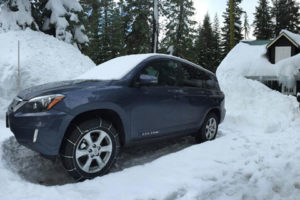
In May 2016, I reached three years of driving my 2012 Toyota Rav4 EV. I’ve already written a number of articles about the Rav4 EV, and after 3 years of driving I’d like to answer a couple of key questions, such as “How much energy does it take to drive an electric car?” , “Why do I drive an EV?” and perhaps most importantly, “Why is this important to me?”
Here are the 4 reasons why I drive electric.
1: Power your car with domestic energy
By driving electric you decrease our reliance on foreign energy. I drive a car powered by 100% American made energy. Domestic energy = Independence.
2: Pollution is real folks, and it is not good for us.
There are 300 million cars on the road in the US. The average person drives 35 miles a day, in a car that gets maybe 20-25 miles per gallon. As a result, we use more than 300 million gallons of gas every day (the actual number is 384 million gallons of gas each and every day). And that’s just for cars and light trucks. Why does that matter? Burning a gallon of gas produces 20 pounds of CO2. So that’s 20 pounds times 384 million. Every day. That’s over 7 billion pounds of CO2. Yes, billion with a B. 7 billion pounds of CO2 that we pump into the atmosphere every day. But that’s not all. Burning gasoline also produces nitrogen oxides; volatile compounds from unburned or partially burned fuel; carbon monoxide; sulphur dioxide; particulate matter and other toxins like benzene, 1,3-butadiene, acrolein, and formaldehyde. Even if we aren’t familiar with the names of those compounds, we already know car exhaust is bad: nobody would let their child sit in a garage with a running car for an hour. But yet we treat the atmosphere like it’s a limitless reservoir that we can pump billions of pounds of toxins into every single day. And keep in mind that current research is providing more and more evidence for how air pollution impairs our health, and the health of our children.
3: Electric cars are much cleaner, and get cleaner every year
Opponents say that EVs just shift emissions from the tailpipe to some coal burning plant down the road. But very few areas in the US rely solely on coal for power any more. There has been a big shift to natural gas (which burns cleaner), and there is steady, continual growth in the amount of electricity generated by renewable solar, wind and hydro sources. 13% of energy in the US comes from renewables that greatly reduce emissions. As a result, the amount of pollution produced by driving an electric car is much less than that made by the average gas powered car. AND it gets better each year. The Union of Concerned Scientists analyzed the amount of pollution made by charging an electric car in different regions of the US based on the fuel sources used to generate electricity by regional utilities. In the worst case scenario, you live in Denver and charging your EV makes an amount of pollution equivalent to driving a car that gets 34 MPG. That’s the worst case. In the best case you live in Alaska and get 126 MPG equivalent from your EV. See the 2014 UCS map below. And again, these numbers can improve every single year. As the grid gets cleaner, related emissions go down and the air get cleaner. Many people I know have solar panels and produce as much electricity for the grid on the roof of their house as they need for their house and driving combined. That’s Net-Zero emission driving. And projects like the Honda House demonstrate that you can actually drive a car powered directly by the sun. Sunshine ⇒ Battery ⇒ Car. It’s that Simple.
4: Driving an electric car is a blast!
No need to say more on that last point, EV’s are simply a blast to drive.
Read my full story here.